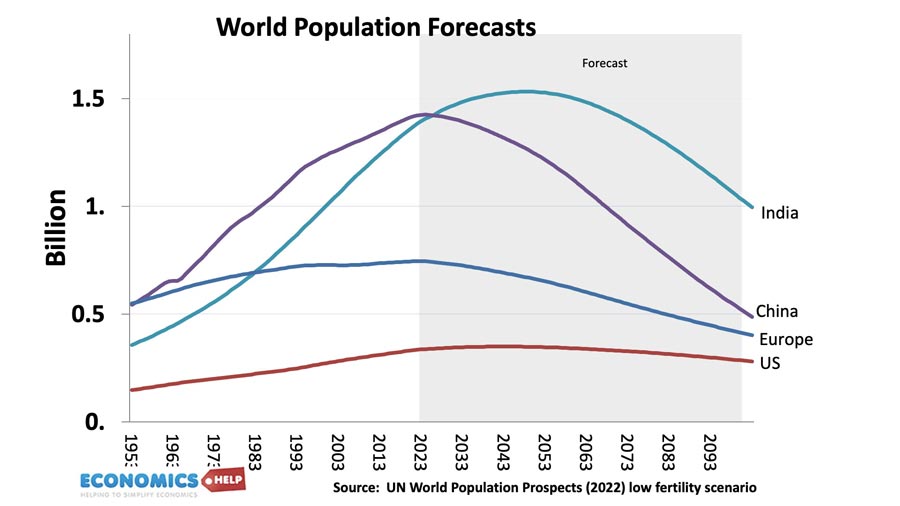
For many decades we worried about population growth. The global population soared. But, then it all started to change very quickly change. The latest UN forecasts suggest the world population is forecast to plummet in the coming decades. The world will change. By 2050, there will be more people in two African countries than the entire European continent. However, bucking these global forecasts, the ONS claims the UK population will continue to rise from 67 to 78 million by 2050. If true, the UK would become the biggest European country by population. However, the ONS have a track record of overestimating fertility rates.
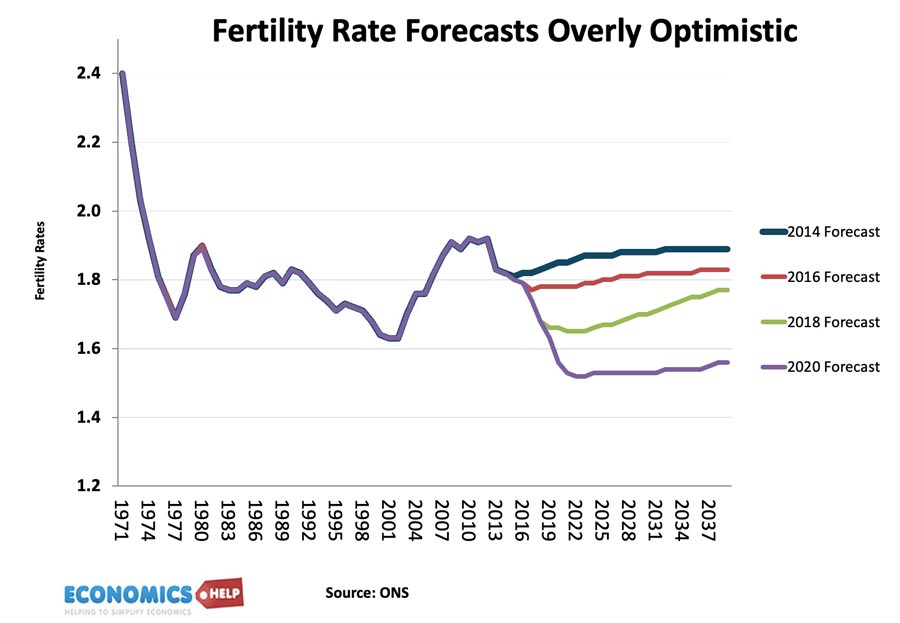
They assume fertility rates will stay the same, but they don’t, they keep falling. Like the rest of Europe, British people are having fewer children, and this trend is speeding up.
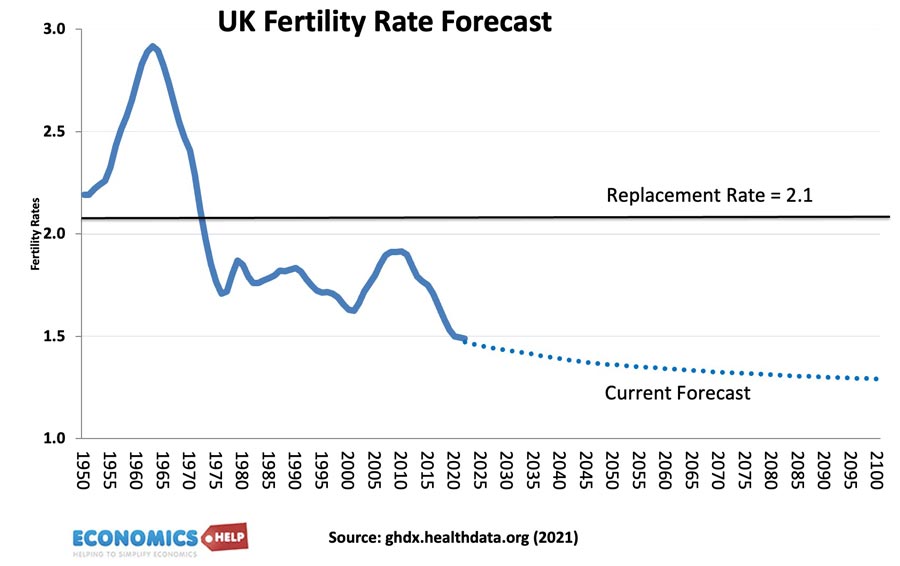
The global burden of disease study found UK fertility is likely to fall from the current 1.5 to 1.2 a similar rate to other European economies.
This has never happened before. It is unprecedented territory for developed economies and it raises the question are we ready for such a scenario?
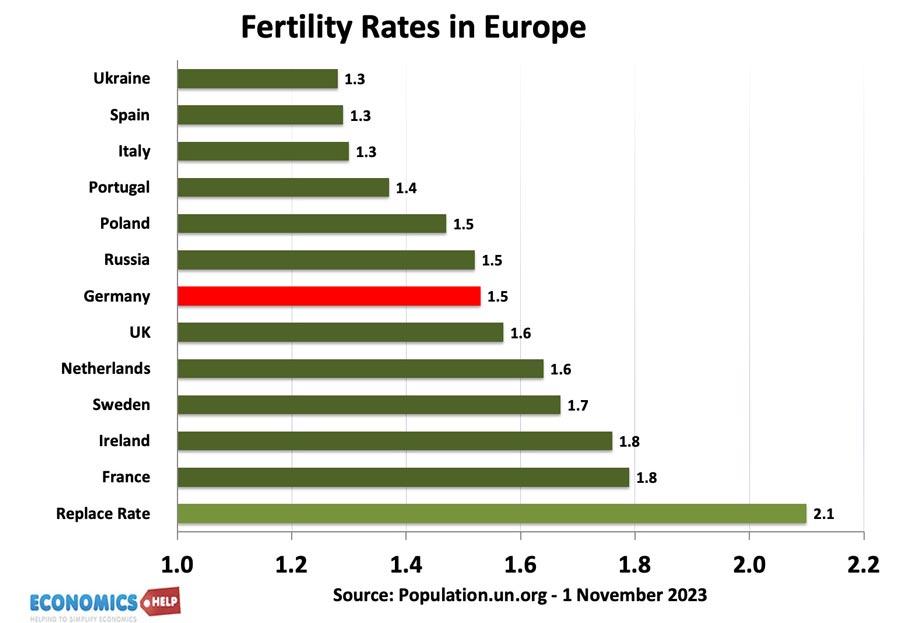
Compared to other European countries, UK fertility rates are fairly average, however, this is still significantly less than the replacement ratio of 2.1 and more importantly, recent trends have all been towards falling birth rates.
Factors causing falling fertility
Firstly, the cost of children has risen significantly. In 2022, including housing and childcare costs, the average cost of raising a child to 18 is estimated to be £223,256 or £12,400 a year. But, even at age 18, the cost of children doesn’t end. The end of free university tuition has caused families to spend more on fees and support. Even after university, you could argue the cost of children doesn’t end. Many parents feel an obligation to help their children onto the housing market or even help pay rent. And this brings us to the second factor – the state of the housing market as an economic barrier. As a share of income, house prices have risen close to record levels. To save for a deposit takes on average 18 years. There is a clear economic rationale to not having children or having smaller families. At the very least, a two-bedroom house is more realistic than a four-bedroom house. Who can afford to have a large family these days? Now at this point, my Yorkshire grandparents might saw we used to sleep four to a room, and we were the lucky ones – but expectations have changed in the past 60 years.
A key factor in falling global fertility rates is a rise in female education and greater access to family planning. In the UK women’s participation in the labour market has increased from 57% in 1975 to 78% in 2017, and continues to rise. In 1980, only 18% of 18-year-olds went to university. In 2020, 53% of women attended. Although there has been a rise in working mothers, career aspirations are a factor in women choosing to not have children. Fifthly, there are other factors at play too. it is even increasingly common for concerns about climate change and global instability to cause people to question whether to bring children into the world. 48% in the UK have expressed this as a concern.
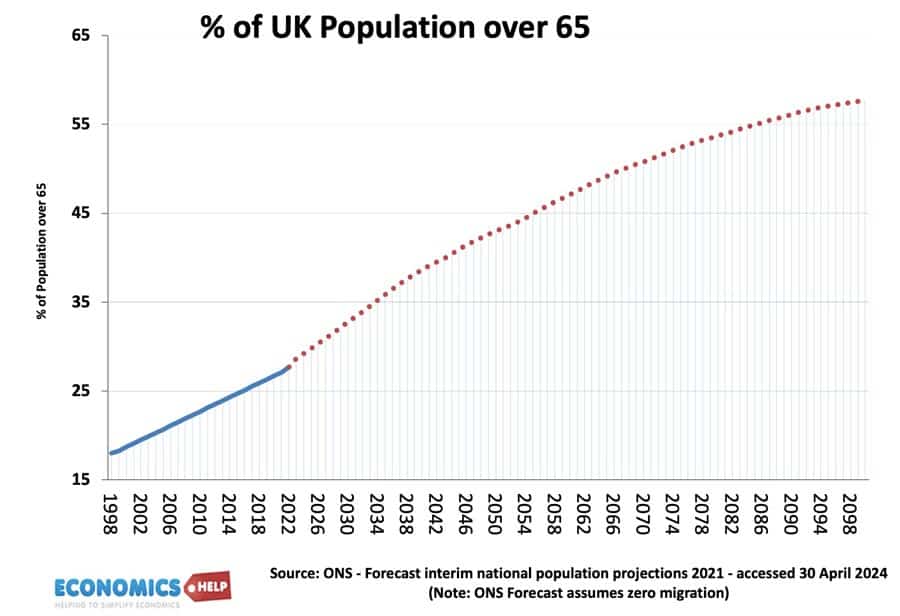
Birth rates are falling, and the UK is definitely going to age. The share of the population over 65 is going to nearly double from 27 to 57%. This will profoundly alter the economy. The first and most obvious impact is that government finances will be stretched, even more than they are already. Pension spending has risen in recent years, but the forecast is for more, perhaps unsustainable increases to come. Recently, the government announced the end of the pension winter fuel discount, saving an estimated £2bn a year, but this is really a drop in the ocean compared to the rise in pension and health care costs to come. One analysis suggests the only way to make an ageing population sustainable is to raise retirement age to 70. To understand the logic of this, under current trends of lower fertility, the dependency ratio is forecast to nearly double from 54% to over 100%. This means for every non-working person, there is one worker. Don’t forget the state pension is not an investment, but is paid for out of current revenue
Higher taxes on shrinking workforce
This raises the prospect of higher taxes on a shrinking workforce. It is the kind of demographic pressure which is very unwelcome. UK debt has risen substantially in the past decade to close to 100%, which is OK, if you have a growing working age population. But, debt becomes unsustainable, when it rises to keep up with a shrinking working population and slower economic growth.
Benefits of falling workforce
Now when we worry about a falling population, we instinctively think of all the negative aspects. But, a decline in the population has some brighter aspects. Firstly, a fall in the population would reduce pressure in the housing market. Given the growth in the number of households, the UK faces an estimated 4 million missing homes. With slower population growth, it would reduce this shortage. And in theory, if population growth did stop, it could play a role in making housing more affordable. Cheaper housing might actually be one of the few things to actually improve fertility rates. Secondly, there is a sense of overcrowding. Roads congested, green belt earmarked for new housing. Tourist spots overcrowded. A decline in the population would ease many of these problems. A fall in the population would also ease environmental pressures. Fewer emissions, less demand for water and natural resources would all ease pressure on the environment. We currently struggle to limit consumption and meet environmental goals, lower population would do the heavy lifting.
That’s all very well, but the problem is getting to this nirvana of lower population may be quite difficult. The fall in fertility rates is forecast to be so extreme we will have unbalanced societies. Schools closing, but more retirement homes, without the people to work there. Of course, technology can go someway to dealing with the decline in population, robots and artificial intelligence to treat the old and infirm. But, is that a future we would look forward to?
There is even a risk current fertility forecasts could be overly optimistic. South Korea has a fertility rate of 0.9, Malta and Hong Kong 1.0. This starts to get really serious. So could anything be done to reverse the trend to lower fertility? Evidence suggests not very much. Even countries which have promoted aggressive pro-natal policies have only seen very limited increases in birth rates. It seems even cash subsidies and childcare do little to move the dial. The global burden of disease reports that pro-natal policies, could lead to a minor one-off increase in birth rates, but it wouldn’t change long-term downward trend.
Immigration
Which brings us to the topic of immigration. One reason for the growth in UK population is immigration, it is currently around 50% of the population growth. As migrants tend to be closer to working age, it is foil for the ageing population of native-born workers. In fact, if there is one simple policy to deal with an ageing population, it is to encourage immigration. It is why countries like Japan and Korea are starting to relax their decade long reluctance to allow foreigners. Yet, whilst migration can play a key role in easing the pressure on government finances and shortages of workers. It is not without stress. Recent record rises in migration saw upward pressure on housing rents, adding to the existing housing crisis rather than solve it. Here the problem was one of magnitude. The end of covid, the Ukraine war, saw a 700,000 increase which is hard to absorb. However, should the working-age population start to shrink, immigration will remain a get-out clause. However, if the population does shrink as much as low-fertility models suggest, maybe it will be harder to attract immigrants than currently.
Related
External sources
https://ifs.org.uk/sites/default/files/output_url_files/BN234.pdf
https://www.ft.com/content/008a1341-1882-4b98-83d4-0d7dc08a4134
https://www.ft.com/content/bfa1e01e-7d55-4d14-b2bb-efd915bc0382
